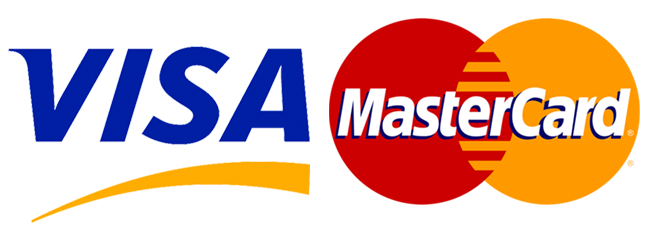
Oyster mushroom diseases and defects usually show up as changes in the shape, color, or surface of the caps and stems — making the mushrooms look less appealing and harder to sell.
In most cases, these issues are caused not by infection, but by imbalances in the growing environment.
The most common reasons include:
✅Incorrectly set up or miscalculated ventilation, humidification, or heating/cooling systems
✅Sudden fluctuations in temperature or humidity
✅Inconsistent control settings — for example, using timers to regulate humidity can easily cause spikes and drops
📌To maintain stable conditions, humidification should ideally be controlled automatically.
If you don’t have climate controllers in place, it’s easy to miss how much your room’s conditions are fluctuating — even small shifts can affect mushroom development.
The good news is: oyster mushrooms usually “tell” you what’s wrong. Within a few days, signs begin to show on the caps and stems.
Once you learn to recognize these patterns, you’ll often be able to tell exactly what environmental condition caused each defect.
Table of Contents
- Moldy oyster mushrooms
- White fuzzy mold on oyster mushrooms
3. Oyster mushrooms lack moisture
6. Growths and pimples on oyster mushroom
7. Curved and wavy oyster mushroom caps with pimples on the edges
8. Oyster Mushroom Pins Look Like Coral. Spiky Oysters
9. Why is oyster mushroom blue?
10. The effect of furnace gas on oyster mushroom
11. Black spots on oyster mushrooms
12. How to solve my problems with oyster mushroom diseases
Emoji guide: 📌 link | ✅ advice | ▶️ fact |💡important
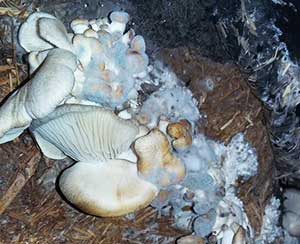
Many growers refer to any infection on dead mushrooms as a "bacterial infection," but that’s not always accurate.
True bacterial infection in oyster mushrooms is caused by Pseudomonas bacteria and is known as Brown Blotch Disease (BBD).
📌Read more about bacterial infections.
Let’s take a look at the photo.
Why did mold appear on these mushrooms?
Initially, the air was too dry, which caused the central mushroom to dehydrate. Its cap turned lifeless and brown.
Later, the two mushrooms seen higher up and to the left began to grow when the humidity level was suddenly increased. But the change was too sharp or too extreme.
In response, the mushrooms turned their caps upward to help release excess moisture from their gills — a defense mechanism.
However, this abrupt fluctuation in humidity stressed the mushrooms and eventually killed them.
Once the mushrooms died, condensation began to collect on them. This moisture created ideal conditions for mold to grow.
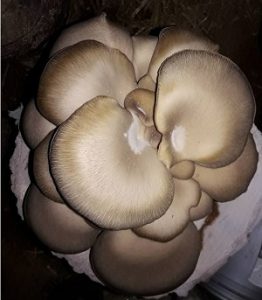
White fuzz doesn’t always mean mold.
If oyster mushrooms are harvested when the caps are fully mature, they tend to store poorly. White spots often appear after a few days in the fridge.
If you see a light white coating in the center of the cap — and it wipes off easily with a finger — this is most likely aerial mycelium, not mold.
These mushrooms are still safe to eat.
But if the white fuzz covers most of the cap and doesn’t wipe off easily, it’s a sign of spoilage.
In that case, it’s best to discard them.
In the photos below, you can see oyster mushrooms with a delicate white coating on the stems — it closely resembles the mycelium that naturally grows on the caps.
This is typically aerial mycelium, which can form when mushrooms are stored in a bag under high humidity and elevated CO₂. It’s a harmless reaction to storage conditions.
However, if the fuzz is thicker, discolored, or has an unpleasant smell, it’s more likely to be mold — and the mushrooms should be discarded.
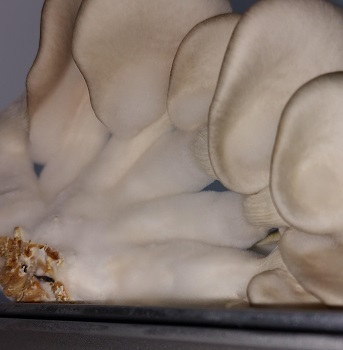
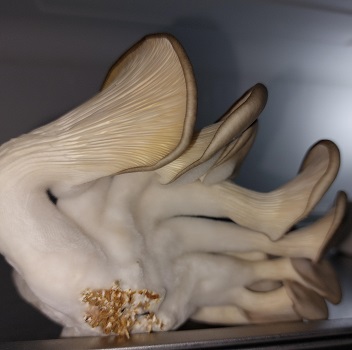
✅Mold usually appears on dead mushrooms when condensation forms due to sharp humidity changes.
✅White fuzz isn't always mold — it’s often aerial mycelium, especially on refrigerated mushrooms.
✅To tell the difference: mycelium wipes off easily and has no odor, while mold is persistent and may smell unpleasant.
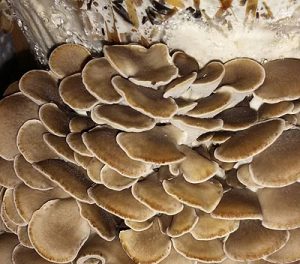
When the airflow in the growing chamber is too strong, it can cause mushroom caps to dry out, crack, and turn yellow — even when the humidity seems fine.
You may notice:
▶️Brown edges that feel dry or even warm to the touch
▶️Cracks or splits forming around the edges of the cap
▶️Yellowing of the surface
▶️Caps curling downward to protect the gills from drying out
This damage often appears on mushrooms still growing in the bags but can also happen after harvesting.
Sometimes caps may crack even under normal airflow if humidity dips temporarily — for example, when the floor is watered and humidity spikes, only to drop again soon after. These sharp fluctuations stress the mushrooms.
 Strong airflow can also create glossy, lacquer-like caps, as seen in the photo.
Strong airflow can also create glossy, lacquer-like caps, as seen in the photo.
This usually happens when the air is not just dry, but also too cold or too hot for oyster mushrooms.
In such conditions, the cap surface becomes shiny, almost polished.
Keep humidity stable in the chamber — ideally between 83% and 90%, depending on the room temperature and mushroom strain.
Make sure fans aren’t blowing directly onto the mushrooms, especially if the air is too dry or if heating/cooling systems create hot or cold drafts.
If you see cap edges starting to curl or develop a leathery texture, check both airflow direction and air temperature — not just humidity levels.
Some oyster mushroom strains — especially many Pulmonarius types — naturally have brownish caps.
That’s normal and healthy.
A stressed mushroom, however, will look dull, unevenly colored, or cracked, unlike the rich, even tone of a healthy brown cap.
📌Learn more about natural cap color
✅Strong airflow can dry out caps, causing cracks, curling, or yellowing.
✅If airflow is both strong and the air is too cold or hot, the cap may develop a shiny, lacquered surface.
✅Stable humidity and even air distribution are key to preventing these issues.
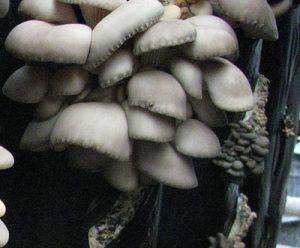
When oyster mushrooms don’t get enough moisture, their appearance changes. You may notice:
▶️Wavy or uneven caps
▶️Small growths or bumps around the edges (see photo)
▶️Caps curling downward — this usually means humidity has dropped slightly to around 80–83%
If the humidity falls even lower, mushrooms start to look dry and feel light.
The gills thin out, turning white or yellowish, and the cap curls up, exposing the gills (see photo below).
In these conditions, the mushrooms age faster to release spores. They grow without proper flesh inside, making them feel hollow and fragile — just skin and gills.
As a result, the caps curl up, exposing the hymenophore. See the image below.
Don’t rely on just one hygrometer — they can be inaccurate. Try one of these:
▶️Use a second humidity sensor to confirm your current readings
▶️Or recalibrate your existing device in a metrology lab
👉 If your mushrooms look dry or yellow, but your sensor shows 89%, it’s a clear sign that something’s wrong with the reading.
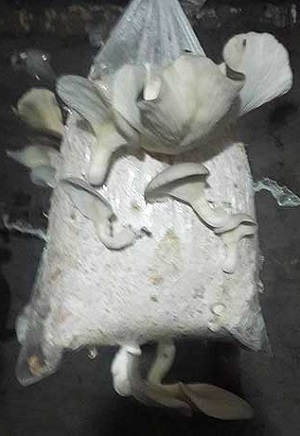
Also:
▶️Place humidity sensors directly near the growing clusters, not just at the top of the chamber
▶️Use several sensors at different points in the room for better accuracy.
If your system uses air ducts, take these steps:
▶️Measure airflow speed using an anemometer — place it directly at the nozzle cup in the duct (you can see what we mean by “nozzle cup” in this photo.)
→ The airflow should be between 26.4–32.8 ft/s (8–10 m/s)
▶️Check airflow direction — if your nozzle cups are pointing sideways or have slipped out of place, adjust them
▶️Inspect the recirculation filter — if it’s dirty, it can reduce humidity in the chamber
✅Low humidity leads to light, dry mushrooms with thin gills and curled caps
✅The appearance of the mushrooms is often more accurate than your hygrometer
✅Always confirm humidity readings with multiple, properly placed devices
✅Airflow issues or dirty filters can also cause low humidity levels

If your oyster mushrooms are growing with:
▶️Long, thin, or curved stems
▶️Small, underdeveloped caps that don’t fully open
▶️Deformed or twisted shapes
...then high levels of carbon dioxide (CO₂) are the most likely cause.
These symptoms show up when fresh air exchange is insufficient and CO₂ builds up in the growing chamber.
📌You can read more about CO₂ levels, how to measure them, and how to adjust your airflow in our dedicated article: Full guide to CO₂ and oyster mushroom growth
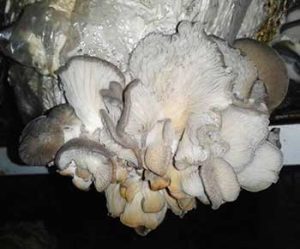
One of the most common reasons for yellowing and curling in oyster mushrooms is excess moisture in the substrate.
When the substrate is too wet, mushrooms can grow twisted or appear to turn inside out.
Their caps may become wavy and turn yellow, while the gills may thicken, become uneven, and shift from white to yellow as well.
▶️With high CO₂: mushrooms may bend, but they still feel firm and healthy inside.
▶️With excess water: mushrooms become soggy, with a soft and watery texture.
If you gently squeeze such a mushroom, water may drip out. The flesh often falls apart between your fingers and gives off an unpleasant odor. These mushrooms are no longer edible — they can’t be cooked or pickled.
For more details about oversaturated substrate and how to avoid it, click here.
💡 Summary: Yellow, soft, and twisted mushrooms often point to a waterlogged substrate. If the mushrooms are firm but misshapen, the issue may be high CO₂ instead.
If you notice white bumps, net-like growths, or small wart-like pimples on oyster mushroom caps, the most likely cause is a combination of low temperatures and elevated CO₂ levels in the growing space.

These white patches are actually secondary mycelium—thin threads (hyphae) that form on the cap surface when the mushrooms are stressed by poor conditions. Sometimes, tiny mushroom pins can even begin to grow from this surface.
A similar-looking white powder may also appear—this is simply spore dust. It settles on caps and nearby surfaces and looks more like a dry, dusty layer than a structural growth.
📌For more information on the risks associated with spores, click here.
Another type of white fuzz can appear on small mushrooms, looking like tiny scales that wipe off easily. These are dead skin cells from the cap surface, suffocated by excessive moisture.
If you see growths or pimples along the cap edge, this typically happens when humidity increases by 3–5%, especially if CO₂ levels rise at the same time.White fuzz can also appear on small mushrooms, resembling tiny scales that can be easily wiped away with a finger.
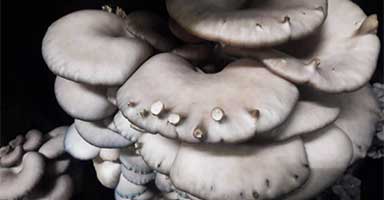
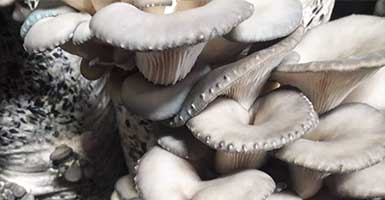
📌More details about these symptoms and examples can be found in a separate article.
💡Summary: White mesh, bumps, or pimples on oyster mushrooms are signs of low temperatures, excess humidity, and high CO₂. The mushrooms are safe but may not look attractive.
In extreme cold (below 10°F / -12°C), outdoor air holds very little moisture. If mostly cold outside air is used with a low rate of recirculation, a paradox occurs: humidifying nozzles operate at maximum, yet humidity remains low.
 This happens because the airflow doesn’t have enough time to absorb moisture, as the flow speed is high and air interaction with the nozzles is brief.
This happens because the airflow doesn’t have enough time to absorb moisture, as the flow speed is high and air interaction with the nozzles is brief.
To address this, many growers hang additional nozzles directly in the grow chamber, near the ceiling. When these nozzles operate periodically—controlled by a timer or humidity sensor—it can result in a wavy edge on the mushroom caps or even make the entire cap wavy.
This effect is especially noticeable if the air in the ducts isn’t humidified after passing through the heat exchanger. As outside air is warmed up, it becomes much drier. This dry, warm air then flows into the grow chamber, reducing the humidity even further.
In such conditions, it’s common to see scales on the mushroom cap, as shown in the photo—these are dead, exfoliated skin cells. These dandruff-like scales are especially noticeable on the left side of the cluster.
1. Adjust Ventilation: Aim to use the minimum amount of outside air to help maintain humidity. Monitor cap shape to ensure it remains acceptable for sale.
2. Manage Temperature Gradually: If it’s difficult to heat the grow chamber during extreme cold, lower the temperature gradually by 1–2°C (1.8–3.6°F) every 4–5 hours.
3. Adjust Humidity Accordingly: Reduce humidity according to the specific requirements of your mushroom strain.
💡Summary: Wavy caps and edge pimples often happen in cold, dry conditions with uneven humidification. Adjust airflow, temperature, and humidity slowly to keep your mushrooms healthy and beautiful
Unusual, coral-like shapes on oyster mushrooms often appear when primordia (pins) form in poor conditions—especially in the absence of light and fresh air.
In photos 1 and 2, you can see how the small pins appeared without air access. Photos 3 and 4 show how they changed once the film was opened and a slight draft introduced.

Many growers compare these growths to a hedgehog, coral reef, or even cauliflower. The shape is visually similar to Hericium erinaceus—also called lion's mane or monkey head mushroom—but if you used oyster spawn, it’s not a different species. It’s just a stress response.
These coral-like clusters form when CO₂ is too high and ventilation or lighting is poor at the primordia stage.
Even though these coral-like pins can continue growing, their final shape is usually far from ideal, even if the conditions are corrected.
💡To solve the problem:
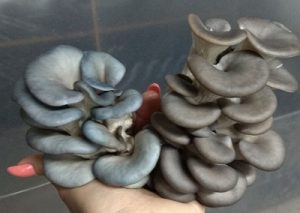
If your normally gray oyster mushrooms suddenly develop a bright blue color, it’s often caused by a sharp temperature drop in the grow room.
The drop must be significant to trigger this blueing effect.
The younger the mushrooms are when this temperature shock happens, the more likely they are to turn blue.
What Happens to the Primordia?
There are two possible outcomes:
▶️If the primordia turn blue, they may still survive and grow into gray-blue mushrooms. To help them recover, gradually raise the temperature. Avoid sudden warming, or the mushrooms may become waterlogged and deformed.
▶️If the primordia turn brown or yellow, it means they’ve died and won’t grow further.
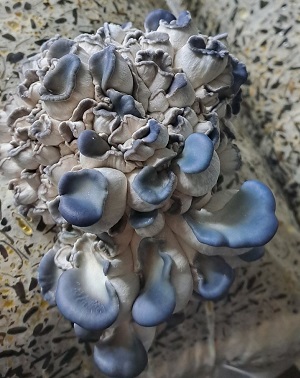
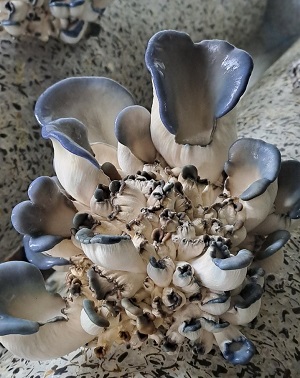
Blueing usually leads to unappealing clusters. Caps may stay closed, and many mushrooms look dry, shriveled, or stunted.
💡Pro tip: If a sharp nighttime temperature drop is expected and you know your heating system may struggle to keep up, start lowering the temperature in the grow room earlier in the day—about 1°C (2°F) every 3–4 hours. Lower the humidity in parallel, by 1% for each degree, to reduce stress on the mushrooms.
When restoring normal conditions, raise both the temperature and humidity just as gradually. A slow and steady adjustment helps protect the primordia and prevents further damage.
If your grow room is heated with a stove or wood-fired boiler, flue gases can poison the mushrooms.
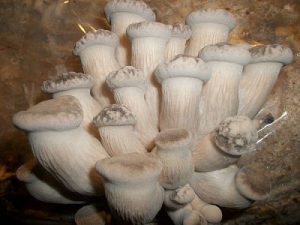
They may develop a light brown tint that doesn’t match the usual color of your strain.
Prolonged exposure to smoke can cause:
▶️Wrinkled or discolored caps
▶️Soft, foam-like stems with altered color and texture
▶️White growths on small mushrooms—a likely defense response from the mycelium trying to protect the primordia
Flue gases can get into the grow room in two main ways:
✅With fresh air intake, especially when wind pushes smoke toward the building or it settles close to the ground
✅Through small cracks in doors or walls, especially if the boiler room is nearby
Mushrooms exposed to smoke or flue gases should not be eaten.
💡The light brown discoloration is likely due to sulfur oxides dissolving in the humid air, forming weak acids that settle on the caps.
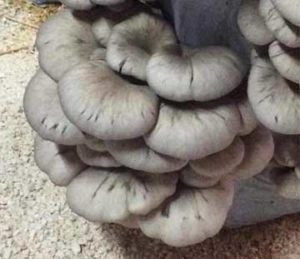
Black or dark streaks that radiate outward on the cap are usually a sign of fluctuating humidity in the grow room.
These streaks form when thin layers of mushroom tissue rupture during the driest periods.
As the surface cracks, pigments may accumulate along these lines, turning them dark or even black.
This can be mistaken for contamination and may discourage potential buyers.
In the photo, the mushrooms developed in a room where humidity swung between 80% and 86%.
The disk humidifier turned on only twice a day, with additional moisture coming from floor wetting.
As a result, the caps not only formed radial streaks, but also developed downward-curved, wavy edges.
If you see this kind of marking, the first step is to stabilize your humidification system—aim to avoid sharp drops or rises in relative humidity.
Temperature swings can also play a role. Sudden shifts may disrupt the formation of new cell layers in the cap, increasing the chances of deformation and dark pigmentation.
💡Summary: Black streaks and wavy caps appear when humidity fluctuates too much—even a 6% swing can make a visible impact.
In this article, I’ve covered the most common types of deformities and unusual changes that can affect oyster mushrooms during cultivation.
⚠️But no article can fully replace a detailed analysis of your specific conditions.
If you’re struggling to figure out what’s going wrong in your grow room — whether it’s a one-time issue or something that keeps coming back — I can help.
I work with mushroom farmers around the world, helping them identify the real cause of crop problems and fix them efficiently.
💡Whether you need a quick diagnosis or full support for your growing cycle, I offer consultations tailored to your setup.
You can check the consultation fees here.
